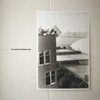Tim Hecker, "Ravedeath, 1972"
 Tim Hecker has made a career out of releasing reliably excellent albums, but aside from rare departures like 2002's Van Halen-inspired My Love is Rotten to the Core, he has always stuck very closely to the hissing, crackling melancholy that he is known for. Ravedeath, 1972 certainly contains more of that (which I am perfectly happy with), but finds Hecker edging out of his comfort zone a little more than I would expect.  The raw material for this album originates from "live" recordings made with a pipe organ at a Reykjavik church, and that organ often emerges from Hecker's digital fog in surprisingly pure form.
Tim Hecker has made a career out of releasing reliably excellent albums, but aside from rare departures like 2002's Van Halen-inspired My Love is Rotten to the Core, he has always stuck very closely to the hissing, crackling melancholy that he is known for. Ravedeath, 1972 certainly contains more of that (which I am perfectly happy with), but finds Hecker edging out of his comfort zone a little more than I would expect.  The raw material for this album originates from "live" recordings made with a pipe organ at a Reykjavik church, and that organ often emerges from Hecker's digital fog in surprisingly pure form.
Tim Hecker's albums always tend to ostensibly explore a complicated abstract theme, though the subtle differences between a Hecker album inspired by "spectral communications" and one inspired by "the cartography of dreams" is probably lost on all but the most devoted fans.  That is not a grievance, as I always enjoy finding out what was occurring in Tim's head during the conception of an album.  It's just that a Tim Hecker album always sounds exactly like Tim Hecker album, regardless of its conceptual underpinning.  In keeping with that tradition, the loose conceptual underpinnings of Ravedeath, 1972 revolve around "digital garbage," an idea that took root when Tim saw footage of a mountain of pirated CDs and DVDs being destroyed by bulldozers in Kazakhstan.  Characteristically, that fascination evolved and expanded into something far more abstract and ineffable by the time the album began to cohere.  To further confuse and fascinate me, the album is also teeming with enigmatic allusions, such as the unexplained titles like "Analog Paralysis, 1978" and "Studio Suicide, 1980," the dates of which are too far in the past to coincide to Hecker's own life.  Mysteries aside, it is clear that the tug of war between music and entropy (digital garbage) has always been a bit of an obsession with Hecker, as his whole aesthetic can succinctly be summed up as "warmth and beauty struggling to emerge from a fog of static."  The only change is that on Ravedeath, 1972, the more melodic parts are a bit more successful at fighting their way to the foreground.
Aside from the aforementioned pipe organ, Hecker also employs some synth and piano (some of which is contributed by engineer Ben Frost).  Oddly, Hecker makes no mention of using guitars, but the warped and woozy sounds in "Studio Suicide, 1980" sure sound like they come from one.  In general, the organ-based pieces tend to be droning, immersive, and almost sacred-sounding (like the beautiful "In the Fog II"), while the piano pieces tend to be more twinkling and delicate.  However, the album flows together quite seamlessly as a whole, held together by the languorously blissful tone and omnipresent hiss and shimmer.
It's a pretty confounding album to try to deconstruct, as the actual musical content of each individual piece is quite simple and minimal, yet sounds so vibrant and ingenious.  For example, the opening piece, "The Piano Drop," is built upon the same few synthesizer chords repeated over and over again, but they quiver, stutter, fade, and swell so much that they are transformed into something quite stunning.  Hecker is singularly adept at something quite intangible–it seems like the actual music that is played during the recording sessions is totally secondary to the eventual outcome, as he has an intuitive understanding of how to use the studio to wrestle pure sound into something with soul and emotional resonance.
It is fairly hopeless to try to contextualize Ravedeath, 1972 as a progression from Hecker's previous work, as he has been at the top of his game for quite some time and that has not changed–he has merely tweaked the formula a bit.  There are some elements here that are a bit more subtle than Tim has been in the past, as he seems to be able to gradually do more and more with less and less. There are also a couple of somewhat daring moments, where he dispenses with his cloak of white noise completely, such as on "No Drums" and "In the Air III."  Even in those cases, however, the music is either submerged-sounding or heavily reverbed.  Ravedeath isn’t an epiphany or a radical transformation; it is merely the work of a master who has found a few small new ways to challenge himself.  This album will deservedly be all over year-end "best of" lists, but anyone unfamiliar with Hecker's artistry could just easily start with Haunt Me, Haunt Me, Do It Again or Harmony In Ultraviolet– this is merely the latest in a long line of great albums.
Samples can be found here.




